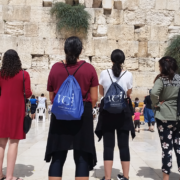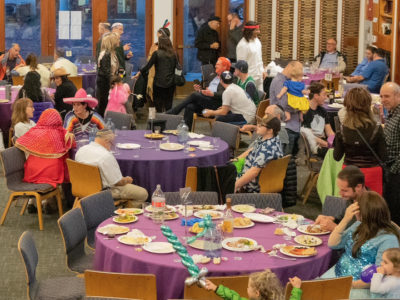By Rabbi-Cantor Cheri Weiss
With the High Holy Days behind us, we move from solemnity and introspection to joy and peace. The week-long festival of Sukkot is traditionally called “Z’man Simchateinu” (season of our rejoicing). It’s the one holiday on the Jewish calendar on which we are actually commanded to be happy:
“You shall rejoice in your festival—you, your son, your daughter, your manservant, your maidservant, the Levite, the stranger, the orphan and the widow who are within your cities.” – Deuteronomy 16:14.
In ancient times, Sukkot marked the culmination of the fall harvest, which is why it is also referred to as Chag Ha’Asif (“Festival of Gathering”). To an agrarian society, expressing gratitude for the successful growth of crops was sincere, because their lives depended on this bounty. During the years when the great Temples stood in Jerusalem, Jews flocked in pilgrimage with their gift offerings to the Priests, where they all celebrated with great joy.
The building of sukkot —temporary huts or “booths” — was established by the rabbis to commemorate the years that the Israelites spent wandering in the desert. The natural material which forms the roof of the sukkah (such as palm fronds or tree branches) must allow the sky and stars to be visible. Seeing the vastness above us as we eat our meals (and for some, sleep at night) allows us the opportunity to be grateful for the food and shelter that we have while being aware that we are part of something much greater than ourselves. In this exposure, we may find freedom: It’s you and nature, you and your family, you and your community.
The temporary nature of the sukkah reminds us of the fragility of life, which can change in a moment. It also serves to remind us that for many in our society, food, shelter, and happiness are not readily available. How we respond to that need is up to each of us. Without all our creature comforts around us, we may take the time to ponder: “What is important to me? What is my true purpose here on earth? How can I feel the ‘sukkat shalom’ (‘shelter of peace’) around me?” Perhaps even Ruach Elohim (the spirit of God) will fill us as we ponder the miracle of the world around us.
On Sukkot, is customary to hold the “four species” — which includes both a lulav (combination of willow, palm, and myrtle branches) and etrog (citron fruit) — in our hands and wave them in all six directions, symbolically reminding us that God is everywhere. Sukkot is also a time to welcome “ushpizin” (guests) into our community! We envision inviting our Jewish ancestors (e.g. Abraham, Sarah, Moses, Miriam, etc.) into our sukkah, while also inviting friends, family and even strangers to join us in celebration of God’s bounty. In sharing what we have with others, we spread the good fortune with which we have been blessed.
Building a sukkah requires the joint effort of willing hands. Building a compassionate community requires the combined effort of willing and caring hearts. May we all join together this Sukkot to be a part of that effort.
Chag Sameach!









Comments